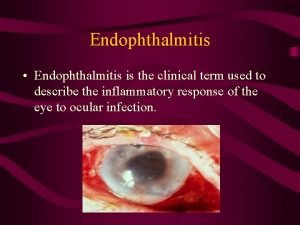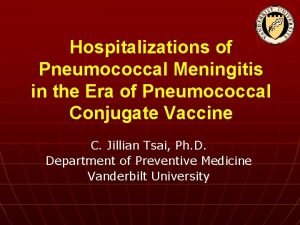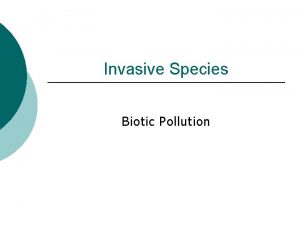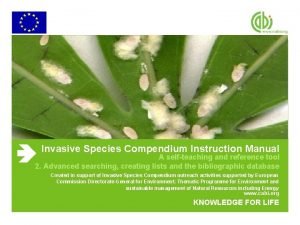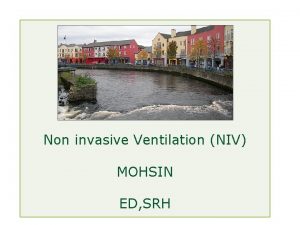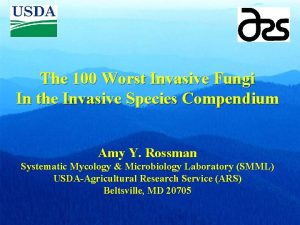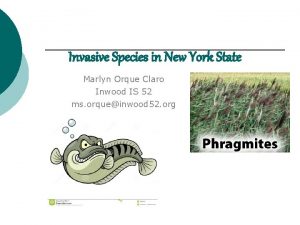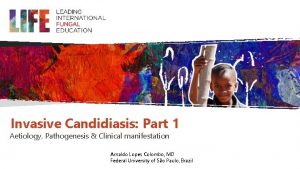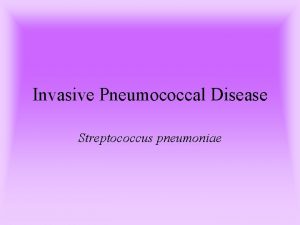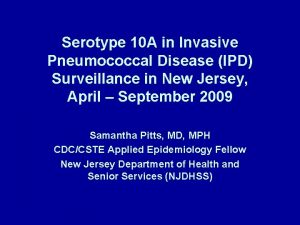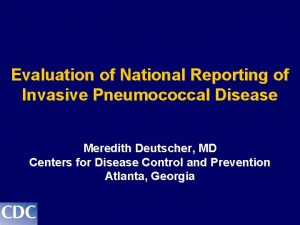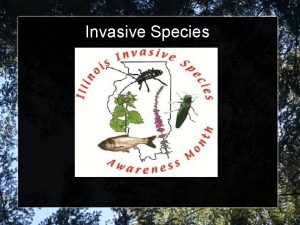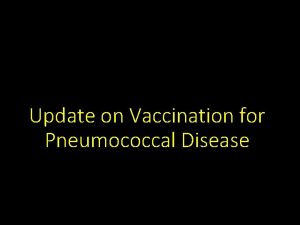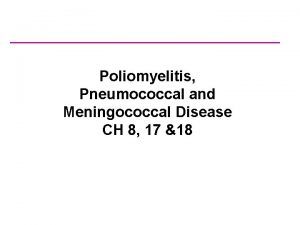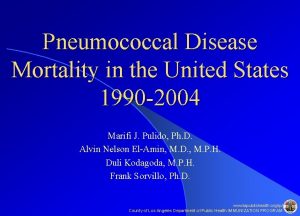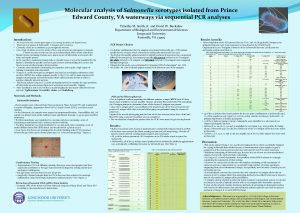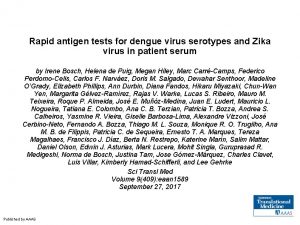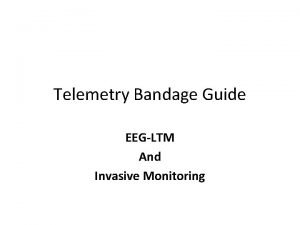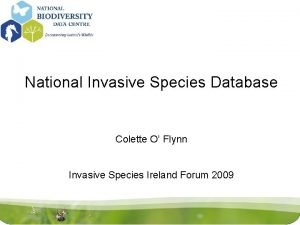Invasive Pneumococcal Disease Serotypes After the Introduction of
























- Slides: 24

Invasive Pneumococcal Disease Serotypes After the Introduction of Pneumococcal Seven. Valent Conjugate Vaccine Arizona, 2001 -2005 Susan Goodykoontz, Daniel Bronson-Lowe, Clare Kioski, Shoana Anderson, Blaine Mathison, Kathy Fredrickson and Rebecca Sunenshine Arizona Department of Health Services National Immunization Conference, Kansas City, MO March 7 th, 2007

Presentation Outline n Review background of invasive pneumococcal disease (IPD) surveillance in Arizona n n Examine changing epidemiology of IPD in Arizona from 2001 to 2005 n n n Reporting Disease Rates Immunization Coverage Serotype Distribution (PCV 7 vs. Non-PCV 7 serotypes) Age Distribution Compare post-vaccination serotype distribution in Arizona to the United States for 2002 Infectious Disease Epidemiology

Background

Reporting of IPD in Arizona n n n Since 1997, Streptococcus pneumoniae isolated from a normally sterile site has been reportable by Arizona laboratories In 2004, IPD became reportable by providers Also in 2004, laboratories were required to forward pneumococcal isolates from sterile sites to the Arizona State Laboratory for serotyping and isolate archiving Infectious Disease Epidemiology

Surveillance Methods n n Case is required to be reported by provider to local health department within 5 days of diagnosis Streptococcus pneumoniae isolated from a normally sterile site is reported by laboratories to ADHS; isolates are required to be forwarded to Arizona State Laboratory (since 2004) Isolates received by Arizona State Laboratory are serotyped and archived Case and laboratory data are entered into the state’s electronic case surveillance system. Additionally, laboratory data are entered into the state’s laboratory electronic data system Infectious Disease Epidemiology

Pneumococcal Seven-Valent Conjugate Vaccine (PCV 7) n n n Introduced in the United States in 2000 Added to United States childhood immunization schedule in 2001 National PCV 7 vaccine shortage from August 2001 through May 2003 Infectious Disease Epidemiology

Invasive Pneumococcal Disease Rates Arizona and United States, 1997 - 2005 PCV 7 Introduction PCV 7 Shortage Source for US data: ABC Surveillance Reports, CDC, 1997 -2005 Infectious Disease Epidemiology

Estimated Vaccine Coverage for Three Doses of PCV 7 Vaccine Arizona and United States, 2003 - 2006 Source: CDC National Immunization Survey, 2003 -2006 data Infectious Disease Epidemiology

Rates of IPD by Age Group Arizona, 2001, 2003, and 2005 Infectious Disease Epidemiology

IPD by Race and Ethnicity Arizona, 2001 and 2005 Black 3% 2001 (n=784) 2005 (n = 726) Infectious Disease Epidemiology

IPD Rates by County Arizona, 2001 Mohave 22. 9 Apache 18. 9 Coconino 25. 4 Yavapai 3. 4 La Paz 0 Yuma 0. 6 Maricopa 14. 8 Gila 13. 6 Pinal 15. 9 Pima 16. 6 Rates/100, 000 persons >=20 10 < rate < 20 <=10 Navajo 19 Santa Cruz 26. 4 Graham 0 Greenlee 0 Cochise 10. 9 Infectious Disease Epidemiology

IPD Rate Ratios by County Arizona, 2001 vs. 2005 Mohave 0. 42* Apache Coconino 0. 79 * 0. 29 Yavapai 1. 15 La Paz 19. 9** Yuma 0. 63 Maricopa 0. 87 Gila 0. 81 Pinal 0. 82 Greenlee Graham 9. 5** Pima 0. 74 *p=0. 05, **p=0. 001 RR <=. 5. 5 < RR < 1 RR >=1 Navajo 0. 72 Santa Cruz 0. 09** 25. 5** Cochise 0. 97 Infectious Disease Epidemiology

Serotype Distribution

Number of IPD Isolates Serotyped at the Arizona State Laboratory and Total Reported IPD Cases, 2000 -2005 Isolates required to be forwarded to State Laboratory Infectious Disease Epidemiology

Rates of Invasive Pneumococcal Disease PCV 7 vs. Non-PCV 7 Serotypes, Arizona, 2001 – 2005 Infectious Disease Epidemiology

Rates of Invasive Pneumococcal Disease PCV 7 vs. Non-PCV 7 Serotypes Children < 5 Years, Arizona, 2001 – 2005 Infectious Disease Epidemiology

PCV 7 vs. Non-PCV 7 Serotypes Arizona, 2001, 2003 and 2005 Infectious Disease Epidemiology

Comparison of Rates by PCV 7 Serotype Status United States and Arizona, 2002 Source for US Data: Beall, B et al. J. Clin. Microbiol, 2006, 44, ( 3). Infectious Disease Epidemiology

Comparison of Rates by PCV 7 Serotype Status in Children < 5 Years United States and Arizona, 2002 Source for US Data: Beall, B et al. J. Clin. Microbiol, 2006, 44, ( 3). Infectious Disease Epidemiology

Serotype Distribution of PCV 7 isolates Arizona, 2001 (n=36) vs. 2005 (n=17) 2001 (n=36) 2005 (n = 17) Infectious Disease Epidemiology

Limitations n n n Incomplete data (i. e. race, demographics) Only reportable by laboratories until 2004 (limited amount of data prior to this time) Forwarding of isolates was not mandatory until 2004 Infectious Disease Epidemiology

Conclusions n n Overall incidence of IPD disease in Arizona has decreased from 2001 - 2005, although this decrease is not statistically significant (p value = 0. 564) PCV 7 immunization is likely reducing the incidence of IPD disease due to PCV 7 serotypes in all age groups in Arizona Non-PCV 7 serotypes have comprised the majority of Arizona IPD disease in all age groups from 20012005 IPD due to non-PCV 7 serotypes has increased in all age groups in Arizona from 2001 -2005 Infectious Disease Epidemiology

Acknowledgements n n Arizona Infection Control Practitioners Mary Finnerty and staff at the Arizona State Laboratory Infectious Disease Epidemiology

Thank you!
 Invasive meningococcal disease
Invasive meningococcal disease Pneumococcal
Pneumococcal Pneumococcal
Pneumococcal After me after me after me
After me after me after me If any man come after me
If any man come after me Bharathi viswanathan
Bharathi viswanathan Invasive species cause
Invasive species cause Invasive ductal carcinoma with medullary features
Invasive ductal carcinoma with medullary features Invasive species characteristics
Invasive species characteristics Invasive species characteristics
Invasive species characteristics Invasive species characteristics
Invasive species characteristics Indiana invasive species council
Indiana invasive species council Invasive species laws
Invasive species laws Aspergilloma treatment duration
Aspergilloma treatment duration Lerman halo
Lerman halo Invasive species compendium
Invasive species compendium Sesleria autumnalis invasive
Sesleria autumnalis invasive Non invasive ventilation
Non invasive ventilation Non invasive ventilation
Non invasive ventilation General aseptic fields are managed critically
General aseptic fields are managed critically Invasive mushroom species
Invasive mushroom species Invasive species investigator worksheet
Invasive species investigator worksheet Invasive candidiasis
Invasive candidiasis Invasive beatmung über tracheostoma
Invasive beatmung über tracheostoma Minimally invasive surgery
Minimally invasive surgery

